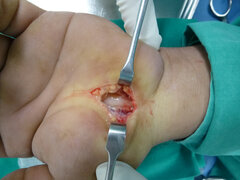Deformities - Injuries
Carpal tunnel syndrome
Carpal tunnel syndrome is quite frequent in women. One of the major nerves of the upper extremity (the median nerve) runs at the wrist level along with flexor tendons in the carpal tunnel whose capacity is limited. Various space occupying entities can further narrow the canal thus affecting the median nerve. The patient may experience pain and complains of numbness, usually nocturnal, of the index and long finger. In late stages loss of dexterity is reported.
Diagnosis is clinical but in ambiguous cases elctrophysiological tests may help, keeping in mind that other causes like a cervical herniated disc can mimic carpal tunnel syndrome. When medical history is short, conservative means may be used (immobilization in a cast, anti-inflammatory drugs).
Surgery is widely used. Usually under local anesthesia carpal tunnel is incised and the nerve is released. I use the WALANT method of local anesthesia meaning that no tourniquet is used, therefore pressure (intolerable in some patients) is not applied to the arm.
Recovery is rapid and patients return to their preoperative activities within weeks. In neglected cases with motor dysfunction of the thumb more sophisticated operations are necessary.
Surgery can also be done endoscopically thus allowing earlier resume of activities. However, at 6 months postoperatively all methods yield equal results in terms of grip strength and motions.
Long-term outcome after surgery depends on the preoperative duration of symptoms and the degree of pressure on the entrapped nerve.
